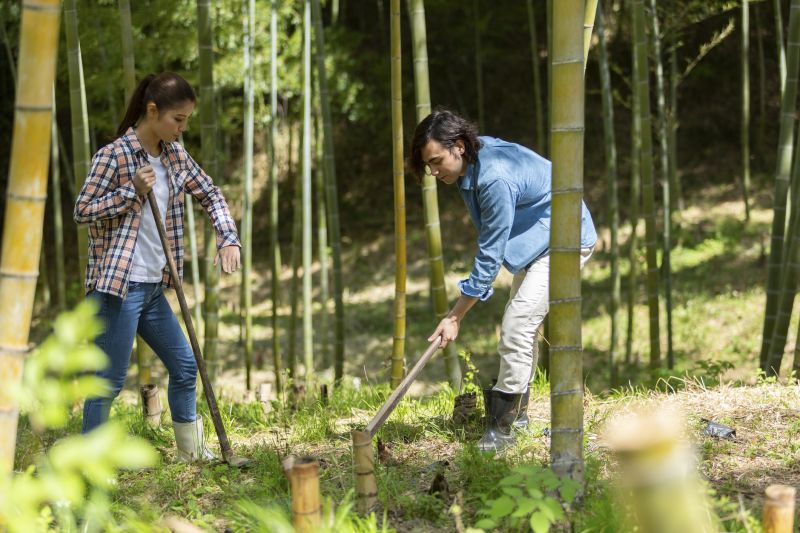Favorite Products for Bamboo Clearing and Removal Services
Identify essential equipment favored by professionals to ensure comprehensive and reliable bamboo removal projects.
 Removing bamboo can be a challenging task due to its rapid growth and extensive root systems. Effective removal often requires specialized tools and techniques to ensure that the bamboo does not regrow or spread uncontrollably. For property owners and landscapers, selecting the right products can make the process more manageable and efficient. From manual tools to chemical solutions, there are various options designed to address different scales of bamboo removal projects.
Removing bamboo can be a challenging task due to its rapid growth and extensive root systems. Effective removal often requires specialized tools and techniques to ensure that the bamboo does not regrow or spread uncontrollably. For property owners and landscapers, selecting the right products can make the process more manageable and efficient. From manual tools to chemical solutions, there are various options designed to address different scales of bamboo removal projects.
Top Overall Option
Heavy-Duty Root Removal Tool
A durable, heavy-duty root removal tool designed to extract bamboo roots effectively. Its robust construction and sharp blades allow for deep penetration into the soil, helping to remove stubborn root systems with minimal effort. Suitable for both professional landscapers and dedicated homeowners, this tool can be a versatile addition to any bamboo removal project.
Types of Products For Bamboo Removal Service
Manual Pruning Saws
Ideal for precise cutting of bamboo stalks and smaller roots, allowing for controlled removal in confined spaces.
Power Chainsaws
Suitable for larger bamboo stalks and thicker canes, providing quick and efficient cutting capabilities.
Brush Cutters
Designed for clearing dense bamboo thickets, these tools can handle thick stalks and undergrowth.
Root Pruning Tools
Specialized tools for cutting and removing bamboo roots underground, helping prevent regrowth.
Herbicide Sprays
Chemical solutions formulated to kill bamboo roots and stalks, often used in conjunction with physical removal.
Stump Grinding Machines
Heavy machinery used to grind down remaining stumps after cutting, ensuring complete removal.
Digging Shovels and Spades
Manual tools for excavating and loosening soil around bamboo roots before removal.
Root Bar and Pry Bars
Leverage tools to lift and extract stubborn bamboo root systems from the soil.
Soil Sterilants
Chemical agents applied to soil to inhibit bamboo root regrowth after removal.
Protective Gear
Safety equipment such as gloves, goggles, and masks to ensure safe handling of tools and chemicals.
Popular Choices
Useful for trimming bamboo stalks quickly and efficiently, especially in maintenance phases.
Effective for pulling out large bamboo roots with minimal soil disturbance.
Concentrated formulas designed for targeted bamboo root treatment, often used with applicators.
Powerful equipment suited for extensive bamboo clearing projects, capable of handling thick stalks.
Handheld saws for precise root cutting, ideal for small to medium bamboo patches.
Attachments for power drills or machinery to grind down bamboo stumps effectively.
Products designed to treat soil after bamboo removal, reducing chances of regrowth.
Lightweight tools for trimming bamboo stalks and managing regrowth in smaller areas.
Robust shovels for excavating and loosening soil around bamboo roots.
Power augers designed to bore into the ground and extract bamboo roots efficiently.
Manual tools such as pruning saws, loppers, and shovels are essential for smaller or more precise removal efforts. These tools allow for careful cutting and extraction of bamboo stalks and roots, minimizing damage to surrounding plants. For larger-scale removal, power equipment like brush cutters, chainsaws, and heavy-duty root removal tools can significantly reduce the time and effort required. Chemical herbicides formulated for woody plants can also be part of a comprehensive removal strategy, especially when dealing with stubborn root systems.
Proper removal not only involves cutting the bamboo but also managing the root system to prevent regrowth. Techniques like root pruning and applying herbicides directly to cut stumps can be effective. It is important to follow safety guidelines and manufacturer instructions when using chemical products or power tools. Additionally, ongoing maintenance may be necessary to ensure that bamboo does not return, especially if any root fragments remain underground.
Choosing the right products depends on the scale of the removal, the type of bamboo, and the surrounding landscape. Investing in quality tools and solutions can facilitate a cleaner, safer, and more efficient removal process. Whether tackling a small bamboo patch or a large infestation, the right equipment and methods are key to achieving successful results.
Key Buying Considerations
- Scale of bamboo infestation: determine whether manual tools or powered equipment are appropriate.
- Type of bamboo: some species have thicker stalks and deeper roots requiring specialized tools.
- Soil conditions: rocky, clay, or loose soil may influence tool choice and effectiveness.
- Safety features: look for tools with safety guards, ergonomic handles, and protective gear compatibility.
- Ease of use: consider user experience level and whether the product is suitable for DIY projects or professional use.
- Chemical compatibility: ensure herbicides are suitable for your specific bamboo type and follow application instructions.
- Environmental considerations: evaluate the impact of chemicals and machinery on the surrounding landscape.
- Maintenance requirements: choose tools that are durable and easy to maintain for long-term use.
- Budget: balance the cost of equipment with the scope of your project and frequency of use.
- Regulatory compliance: verify that chemical products meet local regulations and safety standards.
- Availability of replacement parts: ensure that parts and accessories are accessible for ongoing maintenance.
- Storage and transportation: consider the size and weight of equipment for ease of storage and mobility.
- Additional tools needed: assess if supplementary items like protective gear or soil treatments are required.
- Environmental safety: prioritize products that minimize unintended damage to nearby plants and structures.
- User reviews and ratings: research feedback from other users to gauge product performance and reliability.
This page contains affiliate links. We may earn a commission if you make a purchase through these links, at no additional cost to you.
